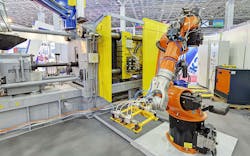Robots Adjust to Foundries’ Demands
According to the most recent FM&T survey data, 16.5% of metalcasting operations plan to invest in robotics technology during 2021 – a total that includes upgrades to existing installations as well as new capital equipment. Robots are more than a trend in metalcasting operations: they are fixtures helping foundries and diecasters to operate more safely, efficiently, and productively. As a result, robotics systems require increasingly specific applications and integration efforts.
In part, this is because metalcasting operations are growing more focused on volume and productivity than ever before. The rise of high-volume, high-pressure diecasting operations are illustrative this trend.
Artimpianti, an industrial contractor, specializes in manufacturing automation for metalcasting operations, especially turnkey production lines for aluminum foundries, with projects completed in Europe, North America, and India. Knowing how to integrate robotics into these lines is a core capability, along with advanced 3D simulation and software expertise.
When it started integrated articulated robots into metalcasting operations 30 years ago, Artimpianti was working to eliminate dangerous work practices and facilitate maintenance – not to reduce production times or improve quality.
Those objectives are very much in place now, however. Automotive industry demand requires a wide degree of production flexibility from foundries. For example, diecasting systems may adjust work volumes according to the particular component to be produced, and the production cell and all its supporting systems must be able to make the adjustment change quickly and reliably.
In the case of a Russian foundry producing castings for a European automaker, Artimpianti designed and automated two production lines of three diecasting machines, in place of a standard “Cartesian axis” installation or floor-mounted articulated robots working in a programmed sequence.
Working with ABB Robotics, a system was developed whereby a special beam supports two cantilever arms, positioned behind the workstations to manipulate the cores and the liquid metal. From the same beam, an ABB IRB6620 six-axis robot was suspended, to remove the castings from the molds and delivering them to the pre-finishing area. There, the castings cool down, sand is removed from the outer surfaces, feeders are cut, and parts are finally placed on a special multi-level cooling conveyor. Once the castings reach the correct temperature they are passed along for final finishing.
The plant layout was designed to improve operator mobility as well as safety, and to give greater visibility in the workstation where manual activity takes place and individuals may be at risk. So now, the workstation operators are able to be close to a mold for analysis, perform regular service, or change the mold without stopping the robot working in the other two work zones. The possibility of changing the mold and/or the tools without stopping the line has significantly improved Overall Equipment Efficiency (OEE) and as a result the productivity.
For this foundry, the robotic installation includes a total of 14 axes and the ABB IRC5 Robot Controller manages six axes of the robot itself, in addition to all the Cartesian axes dedicated to the molding and diecasting processes. In addition to the productivity goals, this customized installation has improved plant ergonomics and safety standards.
With enhanced protection outfits to endure foundries’ heat and shock requirements, the new standards for automation flexibility will find further application in metalcasting – where robots may be found lifting heavy molds, placing delicate cores, pouring hot metal, handling hot castings, or finishing parts with precision and efficiency.
